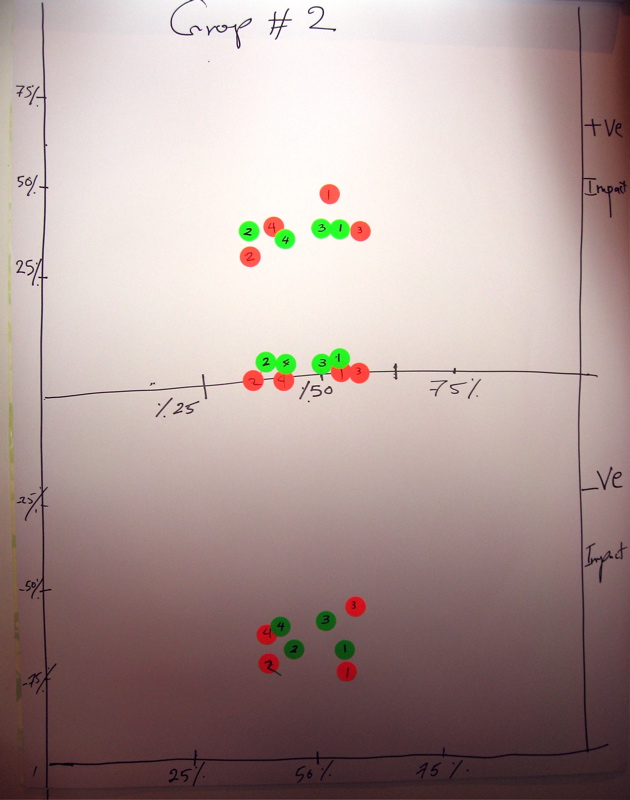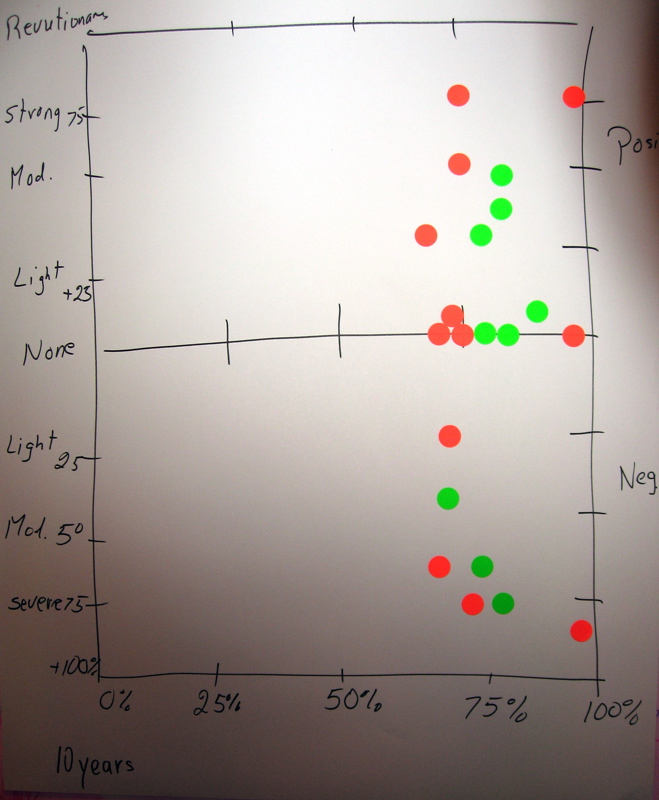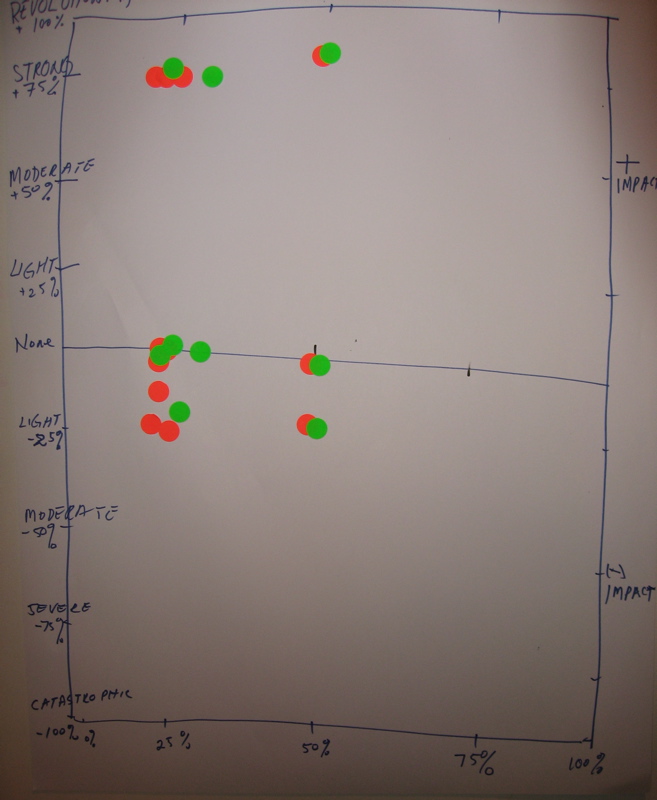|
Forecasting Probabilities and Impacts

The probability impact chart is a tool to evaluate those events that seem on the surface to be the most critical. It involves addressing three separate questions: (1) What is the probability that the event will actually happen during some future period (in this case, the next decade)? (2) Assuming it actually happens, what will its positive impact be on the future of higher education in the Middle East? (3) What will be its negative impact on the future of higher education in the Middle East? The latter two questions taken together force us to stretch our thinking, as is clearly indicated by the report below.
We used the Delphi technique to collect judgments on an event's probability and impact on higher education. Because we changed the composition of groups from the day before where we focused on events, each group identified one event that they considered critical. Then, each person in that group independently evaluated the probability of an impact occurring within the next decade on a 0 – 100 scale and estimated the degree of positive and negative impact on higher education in the Middle East if that event occurred using a 10 point scale. After the independent judgments were made, each group member recorded his or her vote on the flip chart using red paste on dots. Group facilitators then led their groups in a discussion of the following questions: what is the reasoning behind the outliers for both probability and positive and negative impact? The purpose of this approach was to surface the reasoning underlying probability estimates and impact effects. When this discussion was exhausted, each group member re-estimated the probability and degree of positive and degree of negative impact of the event and recorded their vote on the flip chart using green paste on dots. Each group then presented the event and the evaluation of that event to the entire workshop.
Group 1
[Need names of group members.]
Event: Oil Prices drop to US $10
Signal that this event could occur: Progress on renewable energy indicates probability of a major breakthrough in this area.
Discussion on Probability
1. Many countries are committed to find alternate energy resources in the next five years.
2. The probability of this event cannot be higher than 25%; talk of alternative energy sources is the same sort of hype that we see about neural networks, artificial intelligence, and robotics, but the prospect does motivate students.
3. Fuel cells exist. France already has 80% of its energy coming from nuclear sources. The U.S. has re-initiated its alternate energy programs. The probability of alternate energy resources is high.
4. Probability is low due to the expansion of global economy; the dependence on oil is increasing (China for example). Switching to new energy resources with economic value is difficult, and infrastructure for new energy sources is not well developed.
5. The expectation is that there will be a breakthrough in alternate energy resources.
6. Oil reserves all over the world are decreasing, which means that Saudi Arabia will control prices, so the probability of prices going down in less.
7. Probability that a major breakthrough will happen in the next five years is very low, but increases significantly in the next five years.
8. The probability of a breakthrough is 50% because of emerging new alternative sources of energy and rapid growth in supporting of alternate energy research.
Positive impact if this event were to occur:
1. Current planning throughout the region is taking into account financing models that include a decrease in government support.
2. Students will be motivated for education.
3. Positive changes are cultural and will take a long time.
[Need to identify what these changes are.]
4. The importance of education will be increased; people will be forced to enroll in a college or university. It will make our programs competitive.
5. Universities will seek diversified sources of income. Interference from governments will decrease, leading to autonomy, proximity of universities to industry, improved quality of programs, and greater programming flexibility.
6. Universities will seek diversified sources of funding.
7. Universities will rely on technology to provide more cost effective education.
Negative impact if this event were to occur:
1. There are no current initiatives that include benefiting from alternate sources of energy; therefore, negative impact is high.
2. Middle Eastern higher education is unprepared for this event; consequently, the effect will be severe.
3. Funding will be severely impacted; motivation to complete degrees will be low.
4. All funding for public institutions comes from the state; this funding will be substantially reduced. Private universities may not be affected as much.
Group
[Need to know group number and composition.]
Event: Public Higher Educational Institutions Granted Autonomy
[What are the signals that the event could occur within 10 years?]
Positive impact if this event were to occur:
1. Increased efficiency of internal operations due to easier refinements of local processes
2. Better work culture
[Need to define what this means.]
3. Improved work environment
4. Selecting excellent students regardless of their nationalities
5. Better opportunities to contribute to higher education
6. Reduced role of ministries of higher education.
7. More participation of beneficiaries/stakeholders
8. Increase in self-esteem and loyalty of staff/employee of the university
9. Opportunity to attract better faculty and graduate assistants
10 Incrased quality of colleges and universities
11. More diversity in programs
12. Increased responsiveness in adapting academic programs to keep up with market needs
13. Opportunitity to select excellent students regardless of their nationalities
14. Higher attrition rates
15. Increased participation of beneficiaries/stakeholders
16. Easy to adapt academic programs to keep up with market needs
17. Opportunity to diversify sources of funding
Negative impact if this event were to occur:
1. Chaos/turbulence in unprepared institutions
2. Decrease in efficiency in small schools and universities
3. Reduced efficiency in decision making
4. Conflicts with political and cultural trends in the country
5. Reduction in governmental support
6. Creation of new social problems due to more accountability
Group 2
Prof. Michael Iring, Oman
Prof. Abdhu-Rahim Sabouni, UAE
Dr. Farida Ali, Kuwait
Mr. Saleh Hashem, KSA
Event: Oil prices drop to $30 a barrel
Signals that the event will occur:
1. Alternative energy resources are developing
2. New regulations on oil consumption may drive more efficient utilization
3. Current oil prices may be higher than what they should be.
Positive impact if this event were to occur:
1. Diversification of economies
2. Increased efficiency in public and private higher education procedures
3. Middle Eastern colleges and universities will be forced to cooperate
4. There will be more demand for skilled graduates
5. More people will seek education to secure employment
Negative impact if this event were to occur:
1. Redirection in governmental support and funding
2. Higher rate of employment throughout the region
3. Less attractive salaries for academics that may result in lower quality faculty
4. Parents will be less able to fund their children’s education
View Group 2's PI chart.
Group 3
Gerlinde Sarkar, Quatar
Saud Alrabiey, Oman
Satish, Dobai
Mohd Alhamedi, Quatar
Event: State cuts funding to higher education by 20%
Signals that the event could occur:
1. Speeches of key persons in higher education throughout the region
2. Newspaper articles speculating on this possibility
3. Many institutional strategic plans note the possibility
4. In the health sector such cuts are already occurring and care is moving away from public funding
5. Deficit in current governmental budgets
Final Estimate of Probability: 80 – 90%
Positive impact if the event were to occur:
1. Healthy competition between public and private institutions
2. Public institutions will recruit international students
3. Institutions will seek non-academic revenue streams (e.g., applied research)
4. Increase in corporate investment in higher education
5. Increase in scholarship aid from private companies6. Increase in job-oriented programs (e.g., vocational and technical programs)
Negative impact if the event were to occur:
1. Tuition increases throughout region
2. Increases in profit driven private institutions
3. Students will have higher costs
4. Decrease in research funding
5. “Breath of programs” will be limited, with a corresponding slowing of new industries.
View Group 3's PI chart . .
Group Four
Fahad Mohammad Al Naime’, Qatar
Mohammad Sayed Ali Osman, Egypt
Yousaf Abdul Ghaffar , Bahrain
Mukhtar Ahmed, Pakistan
Event: Peace in the Middle East
[What are the signals that the event could occur?]
Final estimate of probability: Three members felt that there will be less probability (25%) of Peace in the Middle East and one person thought that there was a 50% probability that peace would occur within this decade.
Discussion of probability estimate:
1. Inbuilt problems and hard positioning of all stakeholders.
2. Although the involved countries desire peace, defense related industries work against peace.
3. Major super-powers indirectly part of these crises do not try to solve these issues.
4. Natural status quo syndrome
Positive impact if this event were to occur:
1. Increased funding for educational sectors because less allocation will be required for defense/security.
2. Increased stability in the region will trigger more foreign investment and encourage more international educational institutions to locate in the region.
3. Increased cooperation among regional institutions, which may trigger improvement of quality standards in the higher education sector of the region.
Negative impact if this event were to occur:
1. The peace process will encourage countries to open their borders, which will result in students moving throughout the region to select institutions based on cost and quality concerns.
2. Increased competition with foreign institutions, with local institutions suffering in comparison.
3. Increased numbers of students will chose to enroll in European and American institutions of higher learning to the detriment of Middle Eastern institutions.
View Group 4's PI chart . .
Group 5
M. Qasim Jan, Pakistan
Frank McIntosh, Oman
Majid Aldaihani, Kuwait
Esam Agamy, UAE
Event: All government support of higher education withdrawn
[What are the signals that this event could occur?]
Probability: 40%
[What was the final rationale for this probability?]
Negative impact if this event were to occur:
1. Closure of institutions throughout region
2. Reduction of places
3. Possible civil disorder
4. Rise in youth unemployment
5. Skill shortages throughout region in 5-10 years
6. Fall in standards
7. Economic recession
8. Exit of academics throughout region
9. Students begin attending institutions outside of the region.
10. Drop in research activity
Positive impact if this event were to occur:
[Did the group see any positive impact if this event were to occur?]
View Group 5's PI chart. |




 .
.  .
.